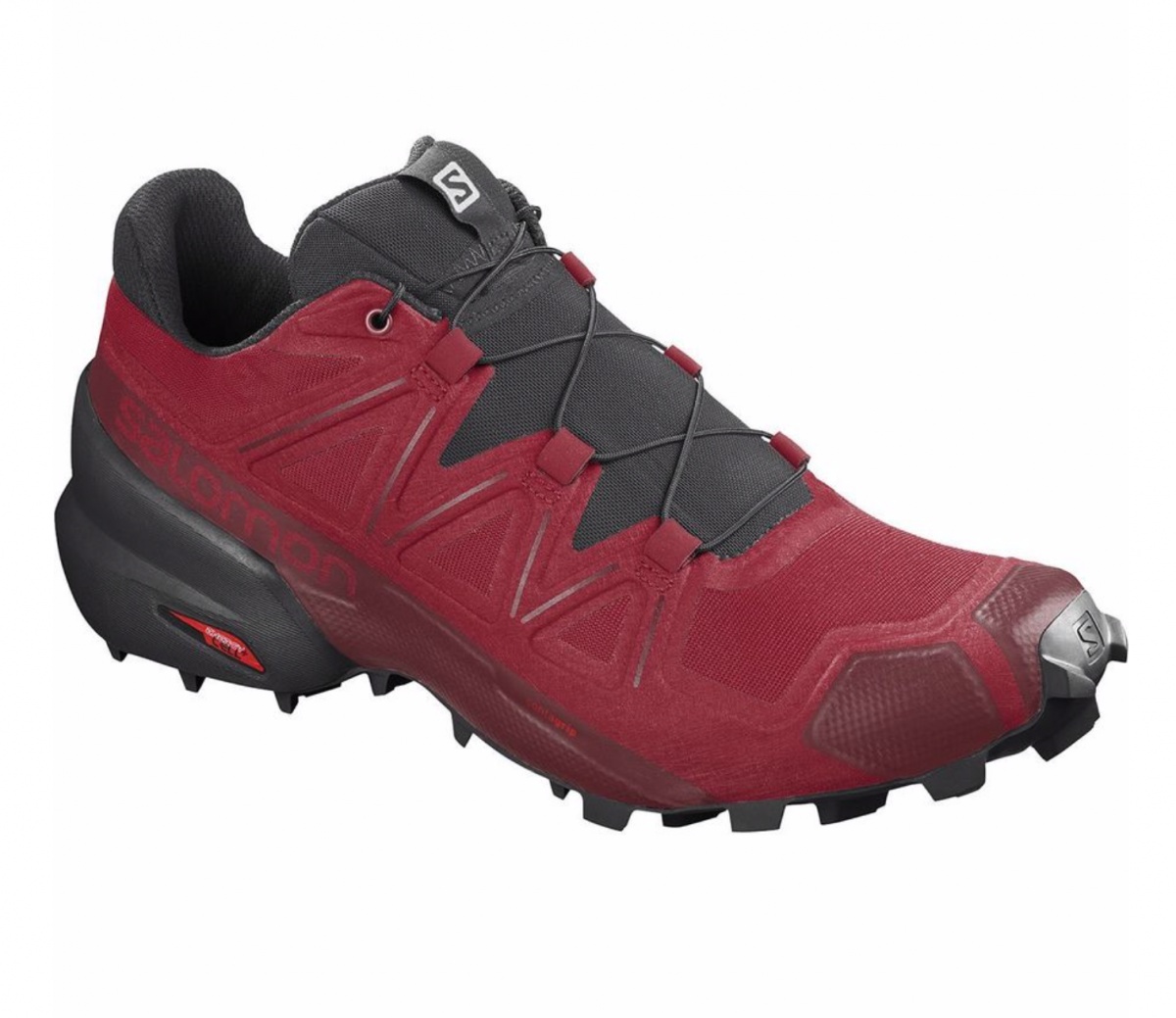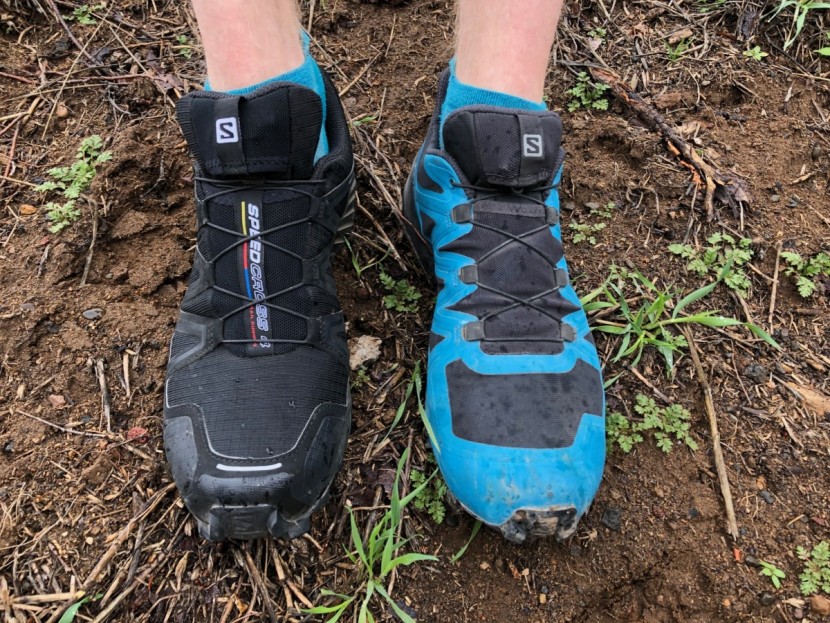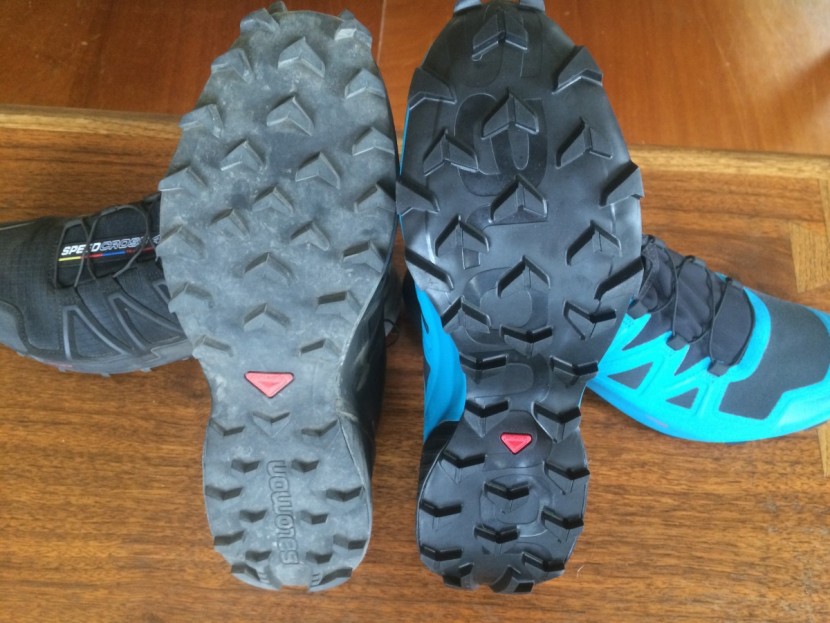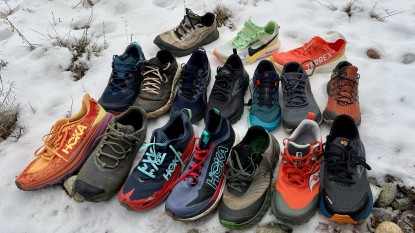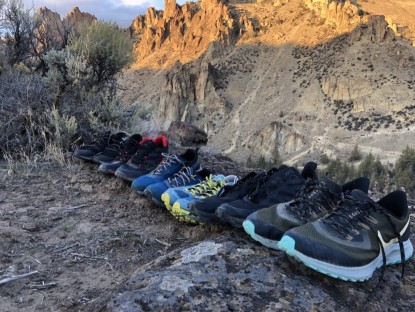Salomon Speedcross 5 Review
Our Verdict
Our Analysis and Test Results
While the Speedcross has always featured 6mm deep arrow-shaped lugs that offer some of the best grips on slippery terrain like snow, mud, and steep grass, the pattern and size of these lugs have changed over the years. With this update, the lugs have been made larger and spaced farther apart, a design meant to help prevent mud buildup on the bottom. Further apart lugs don't accumulate as much mud, but in our experience, the type of mud you are dealing with has far more to do with whether it builds on the bottom of a shoe and if there is the right amount of clay involved, no lug pattern will prevent the mud pancake. However, the best thing about the Contagrip TA outsole is that it is stickier than previous versions. In our intensive testing, it gave outstanding grip on wet rock, not something that is easy to find in a running shoe.
Significantly increasing our joy and comfort is the wider forefoot and toe box design, allowing those without the narrowest of feet to revel in the running pleasure of this shoe as well. If you are a longtime fan of the Speedcross, we think you will be as pleasantly surprised with the newest version as we are, and if you are looking for a new trail shoe that will stick to anything, the Speedcross 5 is the best place to start your search.
Foot Protection
For those who have run in the Speedcross before, you will notice very little to no difference in the feel underfoot of the newest version. It has a stack height of 20mm in the toe and 30mm in the heel, meaning that the heel is extremely well padded, but in the toes and forefoot, there is quite a lot of trail feel. The large lugs provide some protection under the forefoot, and as these wear down over time, the underfoot protection diminishes slightly.
Chronic heel-strikers and those who can handle and love a rather significant (10mm) heel-toe drop will like this shoe better than shoes with a lesser drop. When it comes to protecting the top of the foot and shoe, the Speedcross is one of the best. Combining the protection of the upper and the foam underfoot, we feel that this shoe is slightly better than average.
Traction
Simply put, these shoes offer the very best traction that you can buy. They are an ideal shoe for winter and spring running in the mountains and desert when conditions are often snowy, muddy, rainy, and downright slippery. The only thing they won't grip is ice, but what will? They have deeper, larger, and stickier lugs than their aggressively lugged competitors.
There is a slight downside with the traction on these shoes, which is how soft it is. Softer rubber is used to make the soles as sticky as possible. Very hard rubber simply doesn't grip as well.
With softer rubber comes faster wear times, and so we recommend these shoes for off-trail adventures. We don't necessarily think they are the best choice for simply cruising trails day in and day out, as the lugs will slowly wear down or tear off if you use them this way. In this sense, these Salomons are more of a specialty shoe, well suited to a specific type of use.
Sensitivity
When it comes to sensitivity, these shoes have a very solid balance with foot protection to offer a fair bit of both without sacrificing on either. Most of the sensitivity can be felt under the forefoot, as the thick heel cushioning allows little trail feel to come through. In that way, they feel virtually identical to the previous versions of this shoe.
The most sensitive shoes that we have tested offer very little underfoot protection and require delicate foot placement to avoid injury on rough terrain. We think this shoe offers an ideal balance for the off-trail gnar that it is designed for.
Stability
One of the most notable changes to the new Speedcross 5 is that the forefoot and toe box is significantly wider. We would even venture to call these shoes nearly “normal” width, and they are far higher volume than the super thin and narrow previous versions. In terms of stability, a broader forefoot landing platform allows the foot to splay out more and makes it easier to land correctly without twisting an ankle. The Sensifit upper combined with a quick lace system will easily enable you to cinch these shoes down to the perfect fit for your foot, ensuring that there is no slop and the foot stays firmly locked into the shoe. A shoe that fits snugly and securely is far more stable than a looser fitting shoe that allows the foot to move around inside, a problem that some of our testers had with the wider-fitting options.
The one downside to the stability of this shoe is the very high heel combined with a large 10mm heel-toe drop. Especially when running downhill, we find this combination to be unstable. A smaller heel-toe drop makes for a more stable landing platform. Of course, a much lower stack height, that is, less material underfoot, also dramatically reduces the chances of rolling an ankle. Simply put, the design of this shoe is less stable than most others.
Comfort
This shoe is remarkably comfortable straight out of the box, and we challenge you to find a runner who disagrees. They require no break-in time and do an excellent job cushioning your foot on all sides with comfortable foam padding. New to this iteration is a high heel pad that cradles the Achilles tendon area on the back of the foot gently.
Our only complaint when it comes to comfort is that these shoes really make our feet sweat, no matter what kind of running socks we wear. While there is some breathable mesh, there is nowhere near the amount found on an average trail runner. Much of the mesh is covered by durable overlays. For this reason, it also doesn't drain water very effectively. This shoe is more comfortable in colder weather and isn't our top choice for hot summer days at low elevations.
Weight
Our pair of men's size 11 US shoes weighed 24.4 ounces on our independent scale. A few years ago, that may not have seemed remarkably heavy, but as shoes keep getting lighter and lighter, these are now easily one of the heaviest shoes in our review. Salomon shoes tend to run heavy in general, and you are certainly getting added padding and protection for the added weight, so there is a trade-off to be decided upon.
We don't think these shoes feel like clunkers on the feet despite their heavier weight. Indeed, their sleek design makes them feel rather fast. However, if you are looking for the lightest and most nimble shoes out there, these would not be our first choice.
Should You Buy the Salomon Speedcross 5?
The Salomon Speedcross 5 has seen some very welcome updates that make it better than previous versions of this popular trail shoe. It is wider in the forefoot and now features even stickier and grippier rubber, something we didn't know was possible. For this reason, it regains our Top Pick for Traction award and is our first recommendation if traction is your priority.
What Other Trail Running Shoes Should You Consider?
Used on the right kind of terrain, these shoes perform really well and therefore present excellent value for users who need highly aggressive footwear. A similarly aggressive shoe with more sensitivity worth checking out is the Saucony Peregrine 12. However, as an everyday trail runner, you will likely get more use out of many other shoes. The Brooks Cascadia 16 is a better all-around performer with excellent traction.


